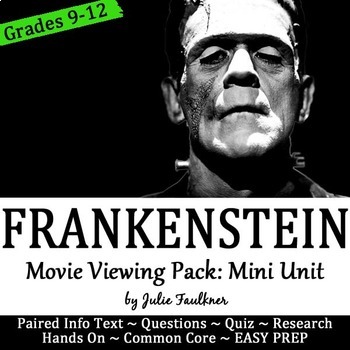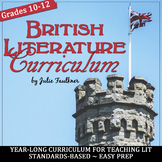Frankenstein Movie Viewing Unit, Questions/Activities, Lesson Plan
- Zip
- Google Apps™

What educators are saying
Also included in
- This complete curriculum is designed for teaching British literature, and you will have a full year's worth of materials for teaching the canon of British literature from Britain's beginnings to today. Teach from Anglo-Saxon literature to Swift's satire to T.S. Eliot's existentialism. With each tPrice $99.45Original Price $110.50Save $11.05
Description
This Frankenstein teaching pack offers creative and original activities that would work very well for making your Frankenstein movie-viewing experience more rigorous and engaging. Students will get the most out of the film by digging into these no prep materials. Each activity works well whether you have read the original manuscript or revised manuscript or view the movie, and each activity included here serves to support the essential questions that drive the unit of study and lead up to the final research paper.
Student Experience: Students will learn background of the author, time period, and story with a brief introductory ppt. Also, before watching, students will read the story of Prometheus to set the groundwork for the conflict and themes. Then, as they watch they can answer text-based questions. Blend close reading exercises and/or paired texts throughout the movie experience, and assess their understanding with a quiz. Next, students can get creative with the build a monster workshop. Last, they can make text-to-self connections with the narrative writing prompt. You also have the option for students to make text-to-world connections with the full-length research paper included here. Your students will love every activity, and you will love that the lessons are classroom-tested, standards-based, and ready-to-go.
Contents:
-Background intro, PPT and digital
-Mythological Pre-Reading Passage with questions and answers, PDF and digital
-Background notes, PDF and digital
-Informational Text Article Thematic Connection
-Your Monsters: A Short Narrative Writing Assignment, PDF and digital
-Build a Monster Workshop: Close reading with a Text-Based Hands On Activity
-Movie viewing guide with answers, PDF and digital
-Movie viewing quiz with answers
-Close Reading of the Novel with Paired Text, PDF and digital
-Argumentative Research paper task and rubric
-Super simple sub plan for movie and questions
**You will need a copy of the film. The best version to use is the Lions Gate Films 2004 Frankenstein with Luke Goss and Donald Sutherland. Directed by Kevin Connor.
Looking for more interesting and engaging movie guides to make showing film in class more rigorous? Check out the following titles:
Classroom success stories from teachers who have tried this resource:
♥ "This is really cool. Very useful for a Frankenstein unit (especially during Halloween when you have a lot of candy ;) )"
♥ "This was perfect for my 10th grade English class. I'm at a high school for Architecture, Construction, and Engineering, and the students had been studying dystopian literature this semester. The topics fit with what they had learned and the assignment needed only minor tweaks for us to use! Thanks a ton!"
♥ "I teach at-risk kids in a drop out prevention program at a career and technical high school. Frankenstein is one of the novels my county strongly suggests us to read in 12th grade. Last year I attempted to teach it, and felt like I was completely drowning; I'm not sure who was more relieved when it was over, me or the kids! Here's to giving Frankenstein a second shot, and hopefully Julie's magic will make it possible for me to not only teach this classic, but hopefully let my kids appreciate it instead of dreading it!"
Be the first to know about my new discounts, freebies and product launches. Look for the green star next to my store logo and click it to FOLLOW ME. Voila! You will now receive email updates about my store.
For more ideas and inspiration:
Julie's Classroom Stories on Instagram
Julie's Classroom Stories on Facebook
Teaching Middle and High School English Facebook Group
Yearbook and Journalism Facebook Group
Terms of Use: Created by Julie Faulkner, updated 2020
Please, one classroom use only. Additional licenses are sold at checkout. This license is nontransferable. Not eligible for online environments unless password protected. Posting openly online is prohibited. No part of this resource can be used for commercial purposes, altered, or resold. This work is my original work, and taking portions of it to create something else for resale is prohibited.




